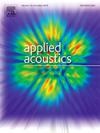Passive acoustic bearing estimation of underwater gas leak using single vector hydrophone
IF 3.4
2区 物理与天体物理
Q1 ACOUSTICS
引用次数: 0
Abstract
Passive acoustic technology is a cost-effective and reliable method for long-term monitoring of submarine gas leaks. However, bearing estimation using a single scalar hydrophone is not feasible, and the deployment of scalar hydrophone arrays is limited due to their large size. In this paper, a local confidence twice-weighted cross-spectral histogram algorithm (LCTW-CHA) based on a single vector hydrophone is proposed for estimating the bearing of the leak. The method involves collecting bubble acoustic signals by a single vector hydrophone and using the conjugate cross-spectrum to determine both the bearing and sound energy flow at each time-frequency point. The sound energy flow is weighted based on local confidence and histogram analysis is then twice weighted by these values, thereby determining the bearing of the leak. Simulation and experimental results demonstrate that LCTW-CHA provides higher accuracy and stability in bearing estimation for underwater gas leaks compared to traditional single-vector hydrophone direction of arrival estimation algorithms.
求助全文
约1分钟内获得全文
求助全文
来源期刊

Applied Acoustics
物理-声学
CiteScore
7.40
自引率
11.80%
发文量
618
审稿时长
7.5 months
期刊介绍:
Since its launch in 1968, Applied Acoustics has been publishing high quality research papers providing state-of-the-art coverage of research findings for engineers and scientists involved in applications of acoustics in the widest sense.
Applied Acoustics looks not only at recent developments in the understanding of acoustics but also at ways of exploiting that understanding. The Journal aims to encourage the exchange of practical experience through publication and in so doing creates a fund of technological information that can be used for solving related problems. The presentation of information in graphical or tabular form is especially encouraged. If a report of a mathematical development is a necessary part of a paper it is important to ensure that it is there only as an integral part of a practical solution to a problem and is supported by data. Applied Acoustics encourages the exchange of practical experience in the following ways: • Complete Papers • Short Technical Notes • Review Articles; and thereby provides a wealth of technological information that can be used to solve related problems.
Manuscripts that address all fields of applications of acoustics ranging from medicine and NDT to the environment and buildings are welcome.
 求助内容:
求助内容: 应助结果提醒方式:
应助结果提醒方式:


